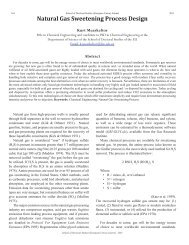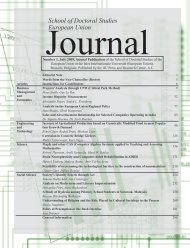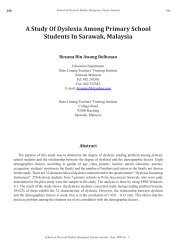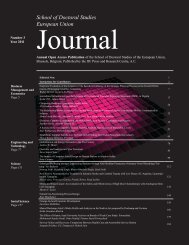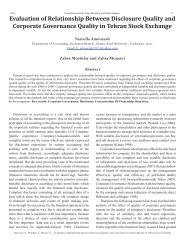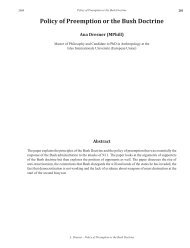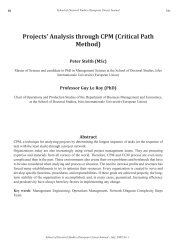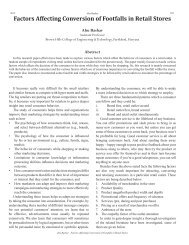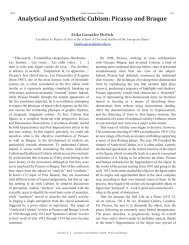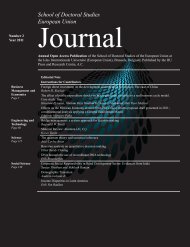Feasibility of overcoming the technological barriers - Isles ...
Feasibility of overcoming the technological barriers - Isles ...
Feasibility of overcoming the technological barriers - Isles ...
Create successful ePaper yourself
Turn your PDF publications into a flip-book with our unique Google optimized e-Paper software.
210<br />
School <strong>of</strong> Doctoral Studies (European Union) Journal<br />
July<br />
<strong>Feasibility</strong> <strong>of</strong> <strong>overcoming</strong> <strong>the</strong> <strong>technological</strong><br />
<strong>barriers</strong> in <strong>the</strong> construction <strong>of</strong> nanomachines<br />
Günter Carr (MSc)<br />
Master <strong>of</strong> Science and candidate to PhD in Physics at <strong>the</strong> School <strong>of</strong> Doctoral<br />
Studies, <strong>Isles</strong> Internationale Université (European Union)<br />
Jeffrey Dessler (PhD)<br />
Chair <strong>of</strong> Nanotechnology Studies <strong>of</strong> <strong>the</strong> Department <strong>of</strong> Engineering and Technology at<br />
<strong>the</strong> School <strong>of</strong> Doctoral Studies, <strong>Isles</strong> Internationale Université (European Union)<br />
Abstract<br />
The Science <strong>of</strong> molecular size machines and its engineering designs and constructions until late 1980s<br />
were not considered practicable. Nanotechnology, according to <strong>the</strong> leading exponents <strong>of</strong> that time were<br />
nei<strong>the</strong>r feasible nor viable, due to <strong>the</strong> fact <strong>of</strong> total structural difference <strong>of</strong> <strong>the</strong> constituent <strong>of</strong> nano-molecular<br />
device i.e. Atoms from <strong>the</strong> mechanical objects <strong>of</strong> every day life. The essential components <strong>of</strong> engineering<br />
mechanics i.e. cogwheels, gears or motors could not be imagined to have formed by means <strong>of</strong> atoms, that<br />
are characterized by fuzzy and unsubstantial contents having no definite location position.<br />
Key words: Nanotechnology, Nanomachines, Mechatronics, Physics, Engineering<br />
School <strong>of</strong> Doctoral Studies (European Union) Journal - July, 2009 No. 1
2009 <strong>Feasibility</strong> <strong>of</strong> <strong>overcoming</strong> <strong>the</strong> <strong>technological</strong> <strong>barriers</strong> in <strong>the</strong> construction <strong>of</strong> nanomachines<br />
211<br />
Nanomachines<br />
The Science <strong>of</strong> molecular size machines and<br />
its engineering designs and constructions until<br />
late 1980s were not considered practicable.<br />
Nanotechnology, according to <strong>the</strong> leading<br />
exponents <strong>of</strong> that time were nei<strong>the</strong>r feasible<br />
nor viable, due to <strong>the</strong> fact <strong>of</strong> total structural<br />
difference <strong>of</strong> <strong>the</strong> constituent <strong>of</strong> nano-molecular<br />
device i.e. Atoms from <strong>the</strong> mechanical objects<br />
<strong>of</strong> every day life. The essential components <strong>of</strong><br />
engineering mechanics i.e. cogwheels, gears or<br />
motors could not be imagined to have formed by<br />
means <strong>of</strong> atoms, that are characterized by fuzzy<br />
and unsubstantial contents having no definite<br />
location position. Edwin Schrödinger, a leading<br />
quantum <strong>the</strong>oretician, regarded <strong>the</strong> particles as not<br />
permanent entity but an instantaneous event and<br />
derived <strong>the</strong> conclusion that atoms could no longer<br />
be regarded as “identifiable individuals”. Werner<br />
Heisenberg, with extreme pessimism described<br />
atoms as “a world <strong>of</strong> potentialities or possibilities”<br />
ra<strong>the</strong>r than “<strong>of</strong> things and facts”. (Is <strong>the</strong> future<br />
nano)<br />
Such ideologies succeeded making <strong>the</strong> scientists<br />
<strong>of</strong> that time convinced to view nanotechnology<br />
as an unattainable objective. During <strong>the</strong> second<br />
half <strong>of</strong> <strong>the</strong> 20 th century some scientists however,<br />
ventured to explore <strong>the</strong> prospects <strong>of</strong> <strong>the</strong> subject.<br />
The efforts began with coinage <strong>of</strong> <strong>the</strong> terminology<br />
<strong>of</strong> molecular engineering by Arthur Von Hippel,<br />
an electric engineer <strong>of</strong> Massachussetts Institute<br />
<strong>of</strong> Technology (MIT) during 1950s and with<br />
his optimistic predictions for possibilities<br />
<strong>of</strong> <strong>the</strong> constructing nano-molecular devices.<br />
Contemporary Nobel laureate and physicist,<br />
Richard Feynman revolutionized <strong>the</strong> concept<br />
through his lecture “There is plenty <strong>of</strong> room at <strong>the</strong><br />
bottom”. (Is <strong>the</strong> future nano) K. Eric Drexler, set<br />
up <strong>the</strong> organization “Foresight Institute, Palo Alto<br />
at California, in 1986 for popularization by <strong>the</strong><br />
concept <strong>of</strong> building materials and products with<br />
atomic precision. Presently, scientists consider it<br />
as <strong>the</strong> pioneer organization for development <strong>of</strong><br />
nanotechnology.<br />
Questions still arise in <strong>the</strong> present scenario with<br />
regard to <strong>the</strong> progress <strong>of</strong> development <strong>of</strong> nanotechnology.<br />
Even though much has been achieved<br />
in <strong>the</strong> field, <strong>the</strong> dreams have not yet been fulfilled<br />
till now. However, developments and intensive<br />
research in <strong>the</strong> field have given rise to revealing<br />
<strong>of</strong> new features <strong>of</strong> atoms, such as robustness <strong>of</strong><br />
atoms to exist independently, facilitating isolation<br />
and counting in units. This feature <strong>of</strong> atoms gives<br />
strength to construct reliable parts <strong>of</strong> working<br />
nano devices. Currently, we have <strong>the</strong> capability to<br />
make <strong>the</strong> atoms move around so as to place <strong>the</strong>m<br />
in desired locations. These achievements in less<br />
than past two decades have led to Nobel Prize<br />
winning contributions in <strong>the</strong> field. The remarkable<br />
contributions <strong>of</strong> Dehmelt <strong>of</strong> University <strong>of</strong><br />
Washington in Seattle, revealing stability <strong>of</strong> even<br />
subatomic particles enabling its isolation within<br />
magnetic traps for months toge<strong>the</strong>r is noteworthy.<br />
(Is <strong>the</strong> future nano)<br />
Table 1. Prizes for elucidating atoms and subatomic particles<br />
Nobel prize Winners Achievement<br />
1986 Gerd Binnig, Heinrich Rohrer Scanning tunnelling microscope<br />
1989 Hans Dehmelt, Wolfgang Paul Traps to isolate atoms and subatomic species<br />
1992 George Charpak Subatomic particle detectors<br />
1994<br />
Clifford Schull,<br />
Neutron diffraction techniques for structure<br />
Bertram Brockhouse<br />
determination<br />
1997<br />
Steven Chu,<br />
Claude Cohen-Tannoudji,<br />
William Phillips<br />
(Source: Is <strong>the</strong> future nano)<br />
Methods to cool and trap atoms with laser<br />
light<br />
G. Carr, J. Dessler - <strong>Feasibility</strong> <strong>of</strong> <strong>overcoming</strong> <strong>the</strong> <strong>technological</strong> <strong>barriers</strong> in <strong>the</strong> construction <strong>of</strong> nanomachines
212<br />
School <strong>of</strong> Doctoral Studies (European Union) Journal<br />
July<br />
Devices constructed from individual atoms<br />
are called Nanomachines. According to some<br />
researchers; in future, to combat disease,<br />
nanomachines will be able to enter living cells.<br />
Nanomachines, which can reorganize atoms in<br />
order to make new objects, can be built in future,<br />
according to <strong>the</strong> researchers. Nanomachines, if<br />
<strong>the</strong> researchers succeed, can be used to get rid <strong>of</strong><br />
poverty by obviously converting dirt into food.<br />
Nanomachines are incredibly small devices, as <strong>the</strong><br />
terminology indicates. They are constructed from<br />
individual atoms and <strong>the</strong>ir size is measured in<br />
nanometers. (Nanomachines: Nanotechnology’s<br />
Big Promise in a Small Package)<br />
There is no macroscopic analogue for<br />
Nanomachine. By atomic scale “pick and<br />
place”, nanomachine would make any structure,<br />
including itself, that is, a set <strong>of</strong> nanoscale<br />
pincers would pick individual atoms from <strong>the</strong>ir<br />
surroundings and place <strong>the</strong>m where <strong>the</strong>y should<br />
go. (Nanotechnology: Nanomachines) Futurist<br />
and visionary K. Eric Drexler made famous <strong>the</strong><br />
capability <strong>of</strong> nanomachines during <strong>the</strong> 1980’s<br />
and 1990’s. K Eric Drexler coined <strong>the</strong> concept <strong>of</strong><br />
nanotechnology during 1986, and made public in<br />
his publication <strong>of</strong> Engines <strong>of</strong> Creation. Drexler<br />
visualized <strong>the</strong> possibilities <strong>of</strong> efficient construction<br />
<strong>of</strong> objects at molecular level with <strong>the</strong> help <strong>of</strong><br />
microscopic machines which were predicted to<br />
be <strong>the</strong> solutions for many ailments <strong>of</strong> <strong>the</strong> present<br />
world. (Book Review: Unbounding <strong>the</strong> Future: The<br />
Nanotechnology Revolution by K. Eric Drexler<br />
and Chris Peterson with Gayle Pergamit)<br />
The production <strong>of</strong> <strong>the</strong> ‘assembler’ is <strong>the</strong><br />
eventual goal <strong>of</strong> nanomachine technology, as per<br />
Drexler. The nanomachine assembler is intended to<br />
influence matter at <strong>the</strong> atomic level. The assembler<br />
will be used to move atoms from existing molecules<br />
into that <strong>of</strong> new structures and will be built with<br />
small ‘pincers’. The idea is that <strong>the</strong> assembler<br />
should fabricate useful items from raw material<br />
by reorganizing atoms. If one can scoop dirt<br />
into a vat and be patient, a team <strong>of</strong> nanomachine<br />
assemblers can change <strong>the</strong> dirt into an apple, a<br />
chair, or even a computer, and this is <strong>the</strong> <strong>the</strong>ory.<br />
A molecular schematic <strong>of</strong> <strong>the</strong> object to be built is<br />
to be put up into <strong>the</strong> memory <strong>of</strong> <strong>the</strong> machines in<br />
<strong>the</strong> vat. Then <strong>the</strong>y would fabricate <strong>the</strong> chosen item<br />
by methodically rearranging <strong>the</strong> atoms enclosed in<br />
<strong>the</strong> dirt. (Nanomachines: Nanotechnology’s Big<br />
Promise in a Small Package)<br />
Though some primordial devices have been<br />
tested, Nanomachines are mainly in <strong>the</strong> phase <strong>of</strong><br />
research development. A sensor with capability to<br />
count specific molecules in a chemical sample, and<br />
having switched approximately 1.5 nanometers<br />
across, is an example. Medical technology is <strong>the</strong><br />
field where nanomachines will find applications<br />
firstly to recognize pathogens and toxins from<br />
<strong>the</strong> samples <strong>of</strong> body fluid. (Nanomachine)<br />
Nanomachines can be used in <strong>the</strong> field <strong>of</strong><br />
pharmaceuticals, to watch over symptoms <strong>of</strong><br />
change in a patient, to treat cancer, AIDS and to use<br />
it for operations <strong>of</strong> those areas which are difficult<br />
for operating upon. (The Ethics <strong>of</strong> Nanotchnology)<br />
It could be used to produce carbon fibers which<br />
would be as strong as Diamond and which also<br />
be less expensive than plastic. Also an important<br />
aspect <strong>of</strong> nanomachines is that this technology<br />
is comparatively less expensive, clean and also<br />
which is easy to maintain than o<strong>the</strong>r technologies<br />
which are presently available. (Book Review:<br />
Unbounding <strong>the</strong> Future: The Nanotechnology<br />
Revolution by K. Eric Drexler and Chris Peterson<br />
with Gayle Pergamit)<br />
School <strong>of</strong> Doctoral Studies (European Union) Journal - July, 2009 No. 1
2009 <strong>Feasibility</strong> <strong>of</strong> <strong>overcoming</strong> <strong>the</strong> <strong>technological</strong> <strong>barriers</strong> in <strong>the</strong> construction <strong>of</strong> nanomachines<br />
213<br />
Respirocytes with Red Cells.<br />
(by Vik Olliver, 1998)<br />
The Ethics <strong>of</strong> Nanotechnology. Retrieved from<br />
http://cseserv.engr.scu.edu/StudentWebPages/<br />
AChen/ResearchPaper.htm<br />
For decades, scientists’ brains are filled with<br />
<strong>the</strong> development <strong>of</strong> nanomachines. The discovery<br />
<strong>of</strong> bio-molecular motors, such as myosin, kinesin<br />
and dynein, roughly 20 years ago, was <strong>the</strong> starting<br />
point for <strong>the</strong> dream <strong>of</strong> constructing machines which<br />
had <strong>the</strong> capacity to copy, replace or to work in<br />
recital with existing bio-molecular machines. The<br />
understanding <strong>of</strong> <strong>the</strong> biophysical and biochemical<br />
properties <strong>of</strong> bio-molecular motors have been<br />
enhanced by present day technologies which<br />
help to watch, influence and analyze particles or<br />
molecules at <strong>the</strong> nanometer scale. Proteins are<br />
<strong>the</strong> bio-molecular motors, which generate forces<br />
and movements within cells, that is, transforming<br />
chemical energy into mechanical energy. The<br />
diverse functions <strong>of</strong> <strong>the</strong>se proteins are such that<br />
some are accountable for rotation and mobility <strong>of</strong><br />
cilia, DNA replication, organelles transport, etc.<br />
(Bio-Molecular Motors Research in Japan: Asian<br />
Technology Information Program)<br />
As an example, <strong>the</strong> mechanical activity <strong>of</strong> biomolecular<br />
motors is sustained by <strong>the</strong> hydrolysis<br />
<strong>of</strong> ATP (adenosin-triphosphate), <strong>the</strong> “fuel”, which<br />
turns out energy for <strong>the</strong> processive movement <strong>of</strong><br />
kinesin along microtubes or <strong>the</strong> contraction <strong>of</strong> <strong>the</strong><br />
actin/muosin complex in muscles. The purposes<br />
<strong>of</strong> bio-molecular machines cannot be read by<br />
equivalence to artificial machines, as <strong>the</strong>y are not<br />
simple. Molecular machines and proteins have an<br />
active structure and have size in comparison to<br />
<strong>the</strong> nanometer range. Also, <strong>the</strong>rmal energy can be<br />
matched up to <strong>the</strong> input energy to <strong>the</strong> molecular<br />
machines and when shown to <strong>the</strong>rmal agitation,<br />
<strong>the</strong> molecular machines function at very high<br />
efficiency.<br />
The artificial machines come in contrast with<br />
molecular machines, as artificial machines use<br />
much higher energy than <strong>the</strong>rmal energy to work<br />
quickly, deterministically and precisely. Hence,<br />
on such grounds, an understanding <strong>of</strong> <strong>the</strong> dynamic<br />
properties <strong>of</strong> proteins and <strong>the</strong>ir interactions among<br />
<strong>the</strong>mselves is essential. The development <strong>of</strong><br />
Single-Molecule Detection (SMD) techniques to<br />
straightforwardly check <strong>the</strong> dynamics <strong>of</strong> proteins<br />
and molecular machines have been extended<br />
to encompass a wide variety <strong>of</strong> biological<br />
sciences. SMD techniques, in amalgamation<br />
with nanotechnology developments, will be<br />
more influential in directing more research in<br />
development <strong>of</strong> nanomachines and that <strong>of</strong> biomolecular<br />
machines. (Bio-Molecular Motors<br />
Research in Japan: Asian Technology Information<br />
Program)<br />
These machines mostly consist <strong>of</strong> proteins<br />
which are syn<strong>the</strong>sized out <strong>of</strong> carbon- <strong>the</strong> chief<br />
ingredient <strong>of</strong> all living things. And as Drexler<br />
explained, <strong>the</strong>se machines, called as assemblers,<br />
will be built on <strong>the</strong> basis <strong>of</strong> one atom at a time, with<br />
<strong>the</strong> capacity <strong>of</strong> being able to fit several hundreds<br />
within a single cell. That <strong>the</strong>se man-made nanoassemblers<br />
will add innumerable variety to <strong>the</strong><br />
countless life forms that are currently known is<br />
agreed from both sides <strong>of</strong> <strong>the</strong> debate. This is due<br />
to a number <strong>of</strong> appealing differences between<br />
<strong>the</strong> assemblers and <strong>the</strong> biological cells on which<br />
<strong>the</strong>y are based. The replication instructions within<br />
<strong>the</strong>se hybrid biological/mechanical machines<br />
to be designed by engineers will be composed<br />
<strong>of</strong> computer code instead <strong>of</strong> DNA is one such<br />
difference worth mentioning.<br />
However, <strong>the</strong>se machines still look like and<br />
perform as existing cell types and this is what<br />
G. Carr, J. Dessler - <strong>Feasibility</strong> <strong>of</strong> <strong>overcoming</strong> <strong>the</strong> <strong>technological</strong> <strong>barriers</strong> in <strong>the</strong> construction <strong>of</strong> nanomachines
214<br />
School <strong>of</strong> Doctoral Studies (European Union) Journal<br />
July<br />
Drexler and o<strong>the</strong>r engineers and nanobiologists<br />
foresee. Viruses are composed <strong>of</strong> proteins and<br />
coding material and its replication is possible only<br />
within a host organism and this nature <strong>of</strong> viruses<br />
will be built into some assemblers. A virus-like<br />
assembler, after entering a cell, utilizing <strong>the</strong> freshly<br />
introduced coding information, can instruct <strong>the</strong><br />
cell’s own internal machinery to replicate. O<strong>the</strong>r<br />
assemblers similar to bacteria will carry within<br />
<strong>the</strong>ir own firm boundaries, all <strong>the</strong> materials which<br />
are required for biosyn<strong>the</strong>sis, and hence would be<br />
independent. They might also make alterations<br />
improving or redesigning <strong>the</strong> original cells by<br />
becoming organelles within eukaryotic cells,<br />
and are also similar to bacteria in this respect.<br />
(Nanomachines and biological systems: Utopia or<br />
Dystopia)<br />
Today’s surgery <strong>of</strong> using a massive blade cutting<br />
through a crowd <strong>of</strong> cells, killing thousands, will<br />
appear pretty barbaric from a cell’s point <strong>of</strong> view.<br />
To stitch up <strong>the</strong> damage, a thick cable is towed in,<br />
and for healing to take place, it is left to <strong>the</strong> cells to<br />
discard <strong>the</strong>ir dead and multiply. The administration<br />
<strong>of</strong> a drug to a patient from <strong>the</strong> cell’s point <strong>of</strong> view<br />
can be visualized as follows: <strong>the</strong> drug molecules,<br />
before recognizing specific molecules by “touch”,<br />
knock pointlessly around till <strong>the</strong>y get adjusted into<br />
<strong>the</strong>ir target molecule. Compare this to a molecular<br />
machine equipped with a nano-computer that<br />
holds data on <strong>the</strong> structure <strong>of</strong> all healthy tissue,<br />
which can feel, prepare, and act at this level.<br />
It is possible to build repair machines with a<br />
size <strong>of</strong> a bacterium, which can enter and leave<br />
cells, can wipe out intruders in <strong>the</strong> blood cells and<br />
can even check <strong>the</strong> DNA itself for any mistakes.<br />
Nowadays, doctors depend on drug molecules and<br />
<strong>the</strong> cell’s capability to mend itself, when a cell is<br />
damaged, even though this process does not always<br />
bring <strong>the</strong> patient back to health. In future, doctors<br />
can restore cells that have been damaged to <strong>the</strong><br />
point <strong>of</strong> inactivity with <strong>the</strong> help <strong>of</strong> nano-devices,<br />
which can repair on <strong>the</strong> smallest components <strong>of</strong><br />
<strong>the</strong> cell. These machines can reconstruct injured<br />
molecules inside <strong>the</strong> cell by getting to <strong>the</strong> base <strong>of</strong><br />
<strong>the</strong> problem. (The Promise <strong>of</strong> Nanotechnology)<br />
Nanomachines can provide support to <strong>the</strong><br />
immune system, because <strong>the</strong>se machines can<br />
fight with natural nanomachines, viruses, and<br />
because <strong>the</strong> body’s own immune system has some<br />
limitations like not remembering <strong>the</strong> shape <strong>of</strong> its<br />
enemies, failing to identify malignant cells and<br />
delaying full development <strong>of</strong> immune reaction.<br />
Nanomachines can make a mammoth contribution<br />
to ageing, can affect bacteria, can influence tumors<br />
and also help in remodeling damaged tissue.<br />
(Nanotechnology and Medicine) The daily work<br />
<strong>of</strong> <strong>the</strong> body is done by <strong>the</strong> molecular machines.<br />
Muscles affect our motions while we chew and<br />
swallow. The bundle <strong>of</strong> molecular fibers, enclosed<br />
in muscle fibers, compress by sliding against<br />
o<strong>the</strong>rs. The molecular machines in stomach and<br />
intestines, called digestive enzymes, break down<br />
<strong>the</strong> complex molecules in food into smaller<br />
molecules and <strong>the</strong>se are used for <strong>the</strong> purpose <strong>of</strong><br />
fuel or are used as building blocks. (Unbounding<br />
<strong>the</strong> Future: The Nanotechnology Revolution)<br />
Useful molecules are carried to <strong>the</strong> bloodstream<br />
by <strong>the</strong> molecular devices which are found in <strong>the</strong><br />
outer layer <strong>of</strong> <strong>the</strong> digestive tract. The molecular<br />
storage devices which are called hemoglobin<br />
enhance oxygen in <strong>the</strong> lungs. The heart, driven by<br />
molecular fibers, pumps blood loaded with fuel<br />
and oxygen to cells. Contraction in <strong>the</strong> muscles<br />
is based on sliding molecular fibers and is driven<br />
by fuel and oxygen. In <strong>the</strong> brain, <strong>the</strong> molecular<br />
pumps that influence nerve cells are done by<br />
nanomachines. Molecular machines in <strong>the</strong> liver that<br />
build and break down a whole mass <strong>of</strong> molecules<br />
are influenced by nanomachines. Such a process is<br />
repeated in o<strong>the</strong>r parts <strong>of</strong> <strong>the</strong> body. (Unbounding<br />
<strong>the</strong> Future: The Nanotechnology Revolution)<br />
Nanomachines which can make replica<br />
<strong>of</strong> <strong>the</strong>mselves are ano<strong>the</strong>r objective <strong>of</strong><br />
nanotechnology. A machine can be able to<br />
construct replica <strong>of</strong> it, if it can reorganize atoms<br />
in order to build new materials. Products which<br />
are thus made by nanomachines will be extremely<br />
low-priced, if this objective is achieved. This is<br />
because, <strong>the</strong> technology, once fine tuned will<br />
not need specific materials, which might be<br />
uncommon and <strong>the</strong>refore cost money, as it will be<br />
self-replicating. Nanotechnology will sign an end<br />
to traditional financial systems is <strong>the</strong> forecast <strong>of</strong><br />
Arthur C. Clarke. A world <strong>of</strong> stimulating promises<br />
School <strong>of</strong> Doctoral Studies (European Union) Journal - July, 2009 No. 1
2009 <strong>Feasibility</strong> <strong>of</strong> <strong>overcoming</strong> <strong>the</strong> <strong>technological</strong> <strong>barriers</strong> in <strong>the</strong> construction <strong>of</strong> nanomachines<br />
215<br />
will open up, if scientists would be able to design<br />
nanomachines which would have <strong>the</strong> capacity to<br />
reorganize atoms. Advanced treatments for many<br />
diseases can be given by nanomachines which are<br />
modeled for different purposes. Injecting medical<br />
nanomachines, programmed to recognize and<br />
disassemble cancerous cells, into <strong>the</strong> bloodstream<br />
<strong>of</strong> cancer victims, can provide a rapid and efficient<br />
treatment for all types <strong>of</strong> cancer. Damaged tissue<br />
and bones can be mended by nanomachines.<br />
(Nanomachines: Nanotechnology’s Big Promise<br />
in a Small Package)<br />
By building molecular support structures by<br />
reassembling nearby tissue, <strong>the</strong>y could even be<br />
used to toughen bones and muscle tissue. Medical<br />
science will speedily adopt treatments for most <strong>of</strong><br />
<strong>the</strong> human illnesses which will have <strong>the</strong> capacity<br />
to influence human cells at <strong>the</strong> minute level.<br />
These treatments will be cheap and accessible to<br />
<strong>the</strong> whole people because nanomachines will be<br />
designed in such a way to make copies <strong>of</strong> <strong>the</strong>m.<br />
If nanotechnology is proved to be effective,<br />
problems relating to shortage <strong>of</strong> food problems <strong>of</strong><br />
hunger can be solved. As nanomachines can have<br />
<strong>the</strong> capacity to change anything into food, this<br />
food could be used to solve problems <strong>of</strong> hunger<br />
worldwide.<br />
Food produced by nanomachines would be less<br />
expensive and would be available to all. As in <strong>the</strong><br />
case <strong>of</strong> food, which enables to influence <strong>the</strong> everincreasing<br />
population, nanomachines would be<br />
able to produce o<strong>the</strong>r goods as well. Also clothing,<br />
houses, televisions, cars and computers would be<br />
made possible at less money. As nanomachines<br />
will change all garbage into new goods which<br />
can be consumed <strong>the</strong>re need not be worries in<br />
relation to <strong>the</strong> garbage produced. (Nanomachines:<br />
Nanotechnology’s Big Promise in a Small Package)<br />
Ano<strong>the</strong>r advantage <strong>of</strong> using nanomachines is<br />
that individual units would require less energy<br />
to operate. Nanites would exist for centuries<br />
before collapsing and hence robustness is ano<strong>the</strong>r<br />
potential asset. (Nanomachine)<br />
The finding <strong>of</strong> toxic chemicals and measuring<br />
<strong>of</strong> <strong>the</strong>ir concentrations, in <strong>the</strong> environment is<br />
ano<strong>the</strong>r prospective application. High operational<br />
speed is possible due to <strong>the</strong> microscopic size <strong>of</strong><br />
nanomachines. (Nanomachine) This is because all<br />
machines and systems will be likely to work faster<br />
as <strong>the</strong>ir size reduces. Nanotechnology can resolve<br />
environmental problems like ozone depletion<br />
and global warming. By releasing clouds <strong>of</strong><br />
nanomachines into <strong>the</strong> upper atmosphere, <strong>the</strong>se<br />
nanomachines can methodically destroy <strong>the</strong> ozone<br />
reducing chlor<strong>of</strong>luorocarbons (CFCs) and build<br />
new ozone molecules out <strong>of</strong> water and carbon<br />
dioxide.<br />
As water and carbondioxide both contain<br />
oxygen, <strong>the</strong> atmosphere contains an abundant<br />
supply <strong>of</strong> oxygen atoms; and so ozone (O3) can be<br />
built out <strong>of</strong> 3 oxygen atoms. Teams <strong>of</strong> dedicated<br />
nanomachines could be engaged to destroy <strong>the</strong><br />
surplus CO2 in <strong>the</strong> lower atmosphere while <strong>the</strong><br />
ozone building teams are at work in <strong>the</strong> upper<br />
atmosphere. CO2 has been recognized as one <strong>of</strong><br />
<strong>the</strong> major contributors to global warming and is<br />
a heat trapping gas. To bring back <strong>the</strong> planet’s<br />
ecosystem and to stop global warming, surplus<br />
CO2 has to be removed, which can be done by<br />
nanomachines. All species on earth will be pr<strong>of</strong>ited<br />
by this. A new era for humanity will begin once <strong>the</strong><br />
nanotechnology is perfected and nanomachines<br />
are produced. This will quickly lead to <strong>the</strong> end<br />
<strong>of</strong> hunger, illness, and environmental problems.<br />
(Nanomachines: Nanotechnology’s Big Promise<br />
in a Small Package)<br />
The intermingling <strong>of</strong> nanotechnology in <strong>the</strong><br />
form <strong>of</strong> nanosize particles into <strong>the</strong> mainstream is<br />
evident in <strong>the</strong> products <strong>of</strong> everyday use such as<br />
sunscreen, paint, cosmetics, and industrial coatings<br />
awaiting its more extensive uses in <strong>the</strong> near future.<br />
Minimization <strong>of</strong> side effects <strong>of</strong> <strong>the</strong> drugs through<br />
<strong>the</strong> preparation <strong>of</strong> accurate combinations with<br />
<strong>the</strong> help <strong>of</strong> nanoparticles is experimented in <strong>the</strong><br />
field <strong>of</strong> Pharmaceuticals. Eradication <strong>of</strong> diseases<br />
like cancer warranted coating <strong>of</strong> <strong>the</strong> receptors <strong>of</strong><br />
cells with nanoparticles <strong>of</strong> drugs that inhibits <strong>the</strong><br />
reproductive cycle. Use <strong>of</strong> Nanosensors for check<br />
up <strong>of</strong> <strong>the</strong> health <strong>of</strong> astronauts is being explored by<br />
<strong>the</strong> NASA and <strong>the</strong> University <strong>of</strong> Michigan.<br />
The aim is to explore <strong>the</strong> method <strong>of</strong> infusing<br />
<strong>the</strong> blood cells <strong>of</strong> astronauts for continuous<br />
monitoring <strong>of</strong> <strong>the</strong> exposure to radiations or o<strong>the</strong>r<br />
infectious agents. Dendrimers and syn<strong>the</strong>tic<br />
G. Carr, J. Dessler - <strong>Feasibility</strong> <strong>of</strong> <strong>overcoming</strong> <strong>the</strong> <strong>technological</strong> <strong>barriers</strong> in <strong>the</strong> construction <strong>of</strong> nanomachines
216<br />
School <strong>of</strong> Doctoral Studies (European Union) Journal<br />
July<br />
polymers having a diameter <strong>of</strong> less than 5nm<br />
are <strong>the</strong> constituents <strong>of</strong> <strong>the</strong> devices. This involves<br />
<strong>the</strong> infusion <strong>of</strong> nanosensors into white blood<br />
cells, for detecting <strong>the</strong> symptoms <strong>of</strong> biochemical<br />
changes due to radiation. The fluorescent tags are<br />
attached in order to make <strong>the</strong> dendrimers glow<br />
with <strong>the</strong> location <strong>of</strong> proteins related to cell death.<br />
Development <strong>of</strong> retinal scanning device with<br />
laser that detects fluorescence from lymphocytes<br />
while passing through <strong>the</strong> capillaries behind retina<br />
is under progress. Taking up <strong>of</strong> blood samples<br />
and transplantation <strong>of</strong> larger sensors resulting in<br />
inflammation or infection is being avoided by use<br />
<strong>of</strong> nanosensors. (A king-size future for nanosize<br />
machines: nanotechnology researchers are laying<br />
<strong>the</strong> groundwork for atomic-scale engineered<br />
systems)<br />
Many controversial debates were<br />
attracted by <strong>the</strong> concept <strong>of</strong> Nanomachines which<br />
is considered to be a bold step in mechanics. The<br />
developments however have been able to restore a<br />
degree <strong>of</strong> confidence among <strong>the</strong> people irrespective<br />
<strong>of</strong> <strong>the</strong> fact that many hurdles are to be overcome<br />
for its fruitful implementation. Remarkable<br />
achievements in this direction are due to <strong>the</strong> recent<br />
developments <strong>of</strong> <strong>the</strong> science towards construction<br />
<strong>of</strong> first molecular assemblers. Demonstration <strong>of</strong><br />
two researchers <strong>of</strong> IBM in <strong>the</strong> field <strong>of</strong> scanningtunneling<br />
microscope by spelling out <strong>the</strong> initial <strong>of</strong><br />
<strong>the</strong> company on <strong>the</strong> atomic scale using 35 Xenon<br />
atoms showed advancement in this direction that<br />
proved <strong>the</strong> capability <strong>of</strong> moving <strong>of</strong> single atoms<br />
with great accuracy. These developments will lead<br />
to occurrence <strong>of</strong> <strong>the</strong> second industrial revolution<br />
within a decade. (A king-size future for nanosize<br />
machines: nanotechnology researchers are laying<br />
<strong>the</strong> groundwork for atomic-scale engineered<br />
systems)<br />
Since <strong>the</strong>re are various methods for constructions<br />
<strong>of</strong> <strong>the</strong> nanomachines it is difficult to predict <strong>the</strong><br />
timeline for this revolution. Research in <strong>the</strong> field<br />
is being fueled by development in <strong>the</strong> related<br />
fields <strong>of</strong> Computer industry, genetic engineering<br />
microminiaturization, physics, and chemistry etc.<br />
Still it is difficult to predict <strong>the</strong> exact method <strong>of</strong><br />
construction <strong>of</strong> first molecular assemblers due to<br />
presence <strong>of</strong> host <strong>of</strong> <strong>technological</strong> difficulties. The<br />
development in <strong>the</strong> field does not seem to be more<br />
impossible in comparison to <strong>the</strong> project <strong>of</strong> sending<br />
man into <strong>the</strong> Space and moon during 1959. The<br />
participation <strong>of</strong> <strong>the</strong> private sector fuelling <strong>the</strong><br />
development <strong>of</strong> nanotechnology makes <strong>the</strong><br />
project advantageous over <strong>the</strong> project <strong>of</strong> man on<br />
<strong>the</strong> moon. Its propounders like Drexler predict <strong>the</strong><br />
replacement <strong>of</strong> conventional factories as well as<br />
<strong>the</strong> fossil fuels <strong>the</strong>y use by making <strong>the</strong> solar cells<br />
more efficient, cheaper and tougher. The evolution<br />
<strong>of</strong> computing power can reach its goal by means<br />
<strong>of</strong> <strong>the</strong> nanotechnology.<br />
In this field <strong>the</strong> evolution <strong>of</strong> nanotechnology<br />
capable <strong>of</strong> building devices many a time faster,<br />
efficient and cheaper will surpass <strong>the</strong> limiting<br />
miniaturization <strong>of</strong> existing electronic methods.<br />
This will lead to preparation faster computers as<br />
small as <strong>the</strong> size <strong>of</strong> a single cell. The formulation<br />
<strong>of</strong> nano computers will revolutionize <strong>the</strong> objects<br />
<strong>of</strong> everyday life. Nanomachines can create tiny<br />
robots <strong>of</strong> <strong>the</strong> size <strong>of</strong> only a few billionths <strong>of</strong> a<br />
meter which seems to be impractical. They are<br />
predicted to bring revolutionary change in lives<br />
in near future. Unclogging <strong>of</strong> arteries, repair <strong>of</strong><br />
damaged cells or DNA will all be possible with<br />
<strong>the</strong> help <strong>of</strong> Nanomachines. Nanorobots will be<br />
able to identify and spoil <strong>the</strong> harmful bacteria<br />
through a simple mouthwash and bring cure from<br />
plaque and tartar. It will be possible to prepare<br />
stronger and lighter materials than steel through<br />
supercomposites constructed out <strong>of</strong> nanostructural<br />
materials bringing revolutionary changes in<br />
construction <strong>of</strong> spaceship and in <strong>the</strong> field <strong>of</strong><br />
space research and travel. (A king-size future for<br />
nanosize machines: nanotechnology researchers<br />
are laying <strong>the</strong> groundwork for atomic-scale<br />
engineered systems)<br />
The necessity <strong>of</strong> <strong>the</strong> power <strong>of</strong> free market is<br />
visualized by Drexler and o<strong>the</strong>rs in <strong>the</strong> field. The use<br />
<strong>of</strong> nanotechnology is propounded most extensively<br />
in <strong>the</strong> field <strong>of</strong> medicines than that <strong>of</strong> o<strong>the</strong>r possible<br />
applications. Deriving <strong>the</strong> impression from <strong>the</strong><br />
use <strong>of</strong> “natural molecular machines” in <strong>the</strong> body<br />
in <strong>the</strong> form <strong>of</strong> digestive enzymes, hemoglobin,<br />
and <strong>the</strong> propounders predicted <strong>the</strong> more efficient<br />
application <strong>of</strong> nanomachines in <strong>the</strong> immunosystem<br />
for destroying harmful virus and bacteria even<br />
School <strong>of</strong> Doctoral Studies (European Union) Journal - July, 2009 No. 1
2009 <strong>Feasibility</strong> <strong>of</strong> <strong>overcoming</strong> <strong>the</strong> <strong>technological</strong> <strong>barriers</strong> in <strong>the</strong> construction <strong>of</strong> nanomachines<br />
217<br />
in a better way than <strong>the</strong> existing natural White<br />
Blood Cells. Application <strong>of</strong> nanomachines in<br />
<strong>the</strong> field can be extended to cleaning <strong>of</strong> blocked<br />
arteries, repair <strong>of</strong> damages cells, re-growing <strong>of</strong><br />
new organs and limbs. It is even predicted to halt<br />
<strong>the</strong> natural aging process at <strong>the</strong> stage <strong>of</strong> its fullest<br />
development. It is predicted to make it possible to<br />
eliminate even <strong>the</strong> eternal teenage scourge through<br />
a nanomachine cream. The only limitation in <strong>the</strong><br />
field seems to be <strong>the</strong> replacement <strong>of</strong> <strong>the</strong> automobile<br />
by <strong>the</strong> nanomachine- built underground railways.<br />
(Book Review: Unbounding <strong>the</strong> Future: The<br />
Nanotechnology Revolution by K. Eric Drexler<br />
and Chris Peterson with Gayle Pergamit)<br />
Nanotechnology presently is at its infant stage,<br />
can be compared with a lit match going to begin<br />
a bonfire <strong>of</strong> strange applications with <strong>the</strong> devotion<br />
<strong>of</strong> engineers that will throw revolutionary<br />
sparking in <strong>the</strong> civilization. The civilization is<br />
on <strong>the</strong> way <strong>of</strong> developing such a field <strong>of</strong> science<br />
and engineering that will have far reaching effects<br />
in o<strong>the</strong>r existing fields. Nanotechnology seems<br />
to be a better avenue existing within ourselves<br />
that has been identified for <strong>the</strong> future success<br />
and glory <strong>of</strong> <strong>the</strong> whole mankind. (The Future <strong>of</strong><br />
Engineering: Nanotechnology: A Mission Into <strong>the</strong><br />
Microscopic)<br />
Nanomachines constitute <strong>the</strong> future hope for<br />
humanity. Curing diseases, fixing <strong>the</strong> atmosphere<br />
and reduction <strong>of</strong> poverty fully is no more a remote<br />
idea but will become a reality with <strong>the</strong> help <strong>of</strong><br />
nanomachines. Overcoming <strong>of</strong> <strong>the</strong> <strong>technological</strong><br />
<strong>barriers</strong> in construction <strong>of</strong> nanomachines by <strong>the</strong><br />
scientist will fetch all <strong>the</strong> goals <strong>of</strong> humanity. The<br />
thirst in this never ending race however, warrants<br />
caution. The irresistible temptation <strong>of</strong> building<br />
self-replicating machines at cheaper rate will<br />
lead to endangering <strong>the</strong> planet with machines<br />
overriding man. It is feared that <strong>the</strong> machines may<br />
devour <strong>the</strong> entire planet in <strong>the</strong> race <strong>of</strong> producing<br />
more and more machines. However, <strong>the</strong> reality <strong>of</strong><br />
<strong>the</strong> benefits those nanomachines assure to fetch<br />
in manipulating matter is quite noteworthy and<br />
deserves pursuance <strong>of</strong> <strong>the</strong> technology with much<br />
enthusiasm.<br />
References<br />
Bio-Molecular Motors Research in Japan. Asian<br />
Technology Information Program (ATIP), 2002<br />
Retrieved from www.atip.org/ATIP/NANO/<br />
reports/atip02.006.pdf Accessed on 26 April,<br />
2004<br />
Chen, Andrew. The Ethics <strong>of</strong> Nanotechnology.<br />
Retrieved from http://cseserv.engr.scu.edu/<br />
StudentWebPages/AChen/ResearchPaper.htm<br />
Accessed on 26 April, 2004<br />
Frischauf, Norbert. Nanotechnology and Medicine.<br />
02, May, 2002 Retrieved from http://www.<br />
itsf.org/resources/factsheet.phpfsID=175<br />
Accessed on 26 April, 2004<br />
Jogi, Vikram. The Ethics <strong>of</strong> Nanotechnology.<br />
Retrieved from www.cs.wmich.edu/~elise/<br />
courses/cs603/Presentation/ Nanotech_<br />
Presentation_022304.ppt Accessed on 26<br />
April, 2004<br />
Nanomachine. 01 December, 2001 Retrieved from<br />
http://whatis.techtarget.com definition/0,,sid9_<br />
gci514355,00.html Accessed on 26 April,<br />
2004<br />
Nanotechnology: Nanomachines Retrieved from<br />
http://www.elcot.com/nano/nanomachine.htm<br />
Accessed on 26 April, 2004<br />
Is <strong>the</strong> future nano Retrieved from http://www.<br />
chemsoc.org/chembytes/ezine/2000/rouvray_<br />
dec00.htm Accessed on 26 April, 2004<br />
Korrane, Kenneth J. A king-size future for<br />
nanosize machines: nanotechnology<br />
researchers are laying <strong>the</strong> groundwork for<br />
atomic-scale engineered systems. (Future<br />
Technology) Machine Design, Sept 19, 2002,<br />
Retrieved from http://www.findarticles.com/<br />
cf_dls/m3125/18_74/92458835/p2/article.<br />
jhtmlterm= Accessed on 26 April, 2004<br />
G. Carr, J. Dessler - <strong>Feasibility</strong> <strong>of</strong> <strong>overcoming</strong> <strong>the</strong> <strong>technological</strong> <strong>barriers</strong> in <strong>the</strong> construction <strong>of</strong> nanomachines
218<br />
School <strong>of</strong> Doctoral Studies (European Union) Journal<br />
July<br />
Person, Lawrence. Book Review: Unbounding <strong>the</strong><br />
Future: The Nanotechnology Revolution by K.<br />
Eric Drexler and Chris Peterson with Gayle<br />
Pergamit. The Freeman: Ideas on Liberty.<br />
November, 1992. Retrieved from http://www.<br />
fee.org/vnews.phpnid=2664 Accessed on 26<br />
April, 2004<br />
Plotnick, Debbie. Nanomachines and biological<br />
systems: Utopia or Dystopia 07 January, 2002<br />
Retrieved from http://serendip.brynmawr.<br />
edu/biology/b103/f00/web2/plotnick2.html<br />
Accessed on 26 April, 2004<br />
Silby, Brent. Nanomachines: Nanotechnology’s<br />
Big Promise in a Small Package. Department<br />
<strong>of</strong> Philosophy. University <strong>of</strong> Canterbury, 2002<br />
Retrieved from http://www.def-logic.com/<br />
articles/nanomachines.html Accessed on 26<br />
April, 2004<br />
Tikoo, Sonia. The Future <strong>of</strong> Engineering:<br />
Nanotechnology: A Mission Into <strong>the</strong><br />
Microscopic. The National Academy <strong>of</strong><br />
Engineering.<br />
Retrieved from http://www.engineergirl.org/<br />
NAE/CWE/egedu.nsf/weblinks/ESER-<br />
5KRS2ROpenDocument Accessed on 26<br />
April, 2004<br />
Unbounding <strong>the</strong> Future: The Nanotechnology<br />
Revolution. Retrieved from http://www.<br />
foresight.org/UTF/Unbound_LBW/chapt_10.<br />
html Accessed on 26 April, 2004<br />
Wisz, Michael S. The Promise <strong>of</strong> Nanotechnology.<br />
Retrieved from http://www.rso.cornell.edu/<br />
scitech/archive/95spr/nano.html Accessed on<br />
26 April, 2004<br />
School <strong>of</strong> Doctoral Studies (European Union) Journal - July, 2009 No. 1



